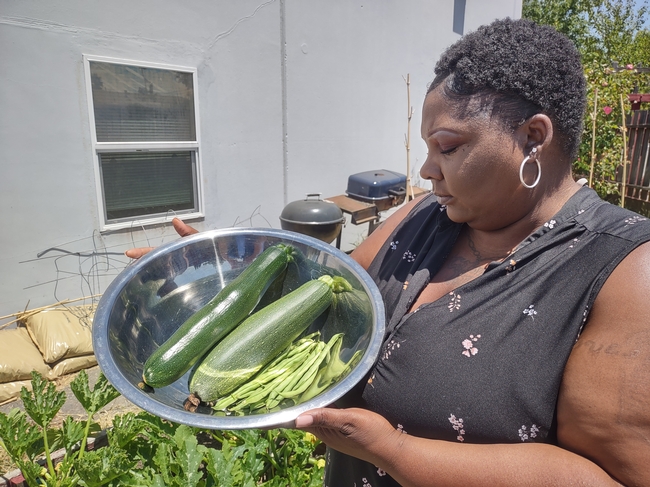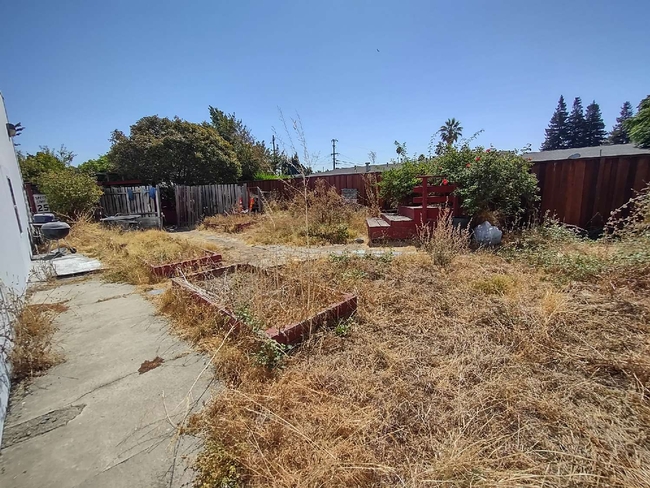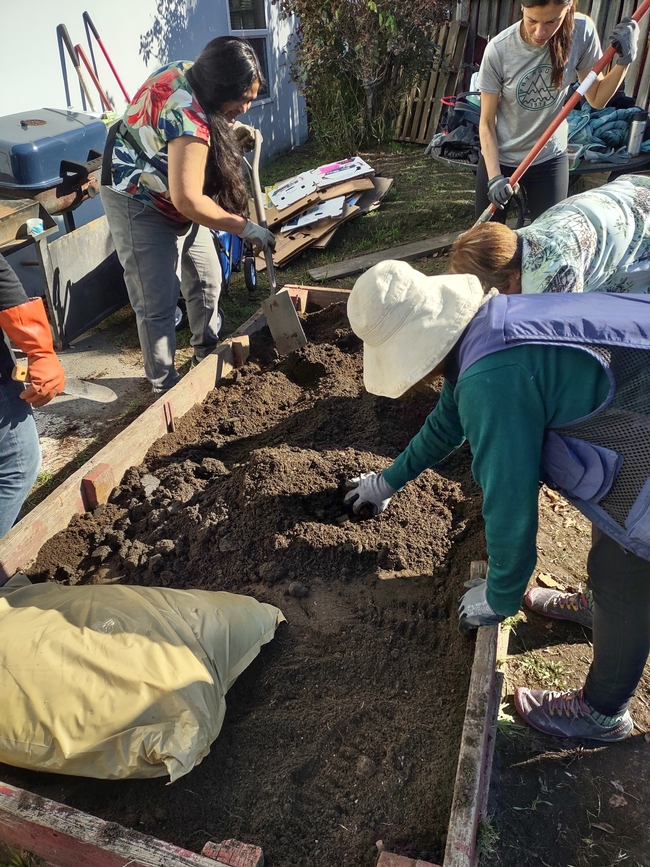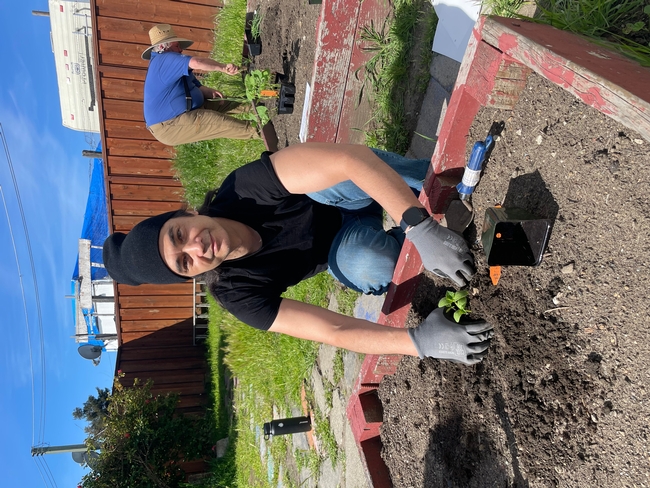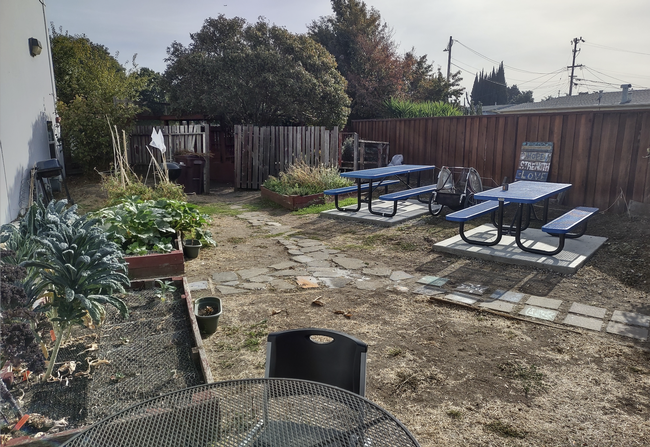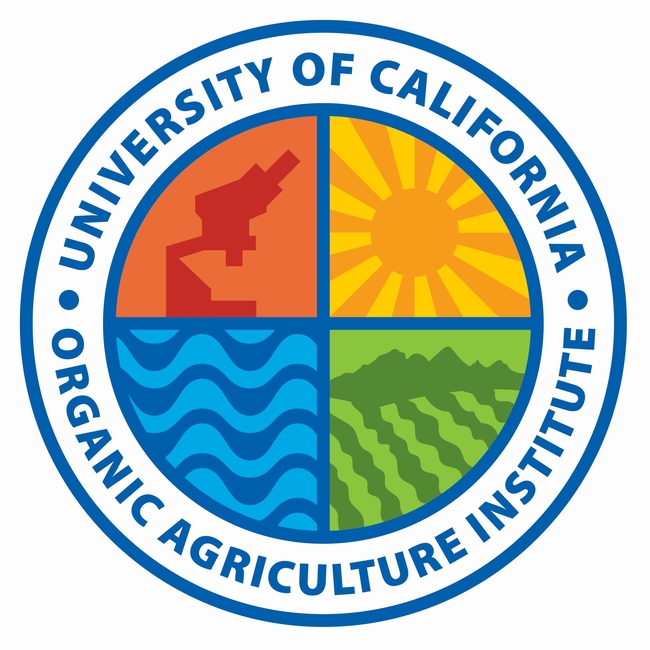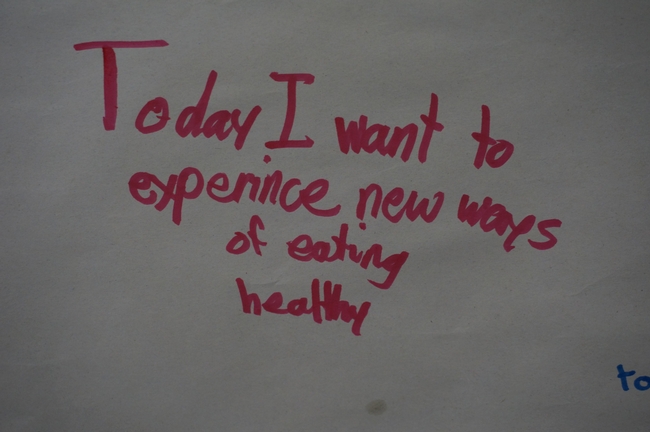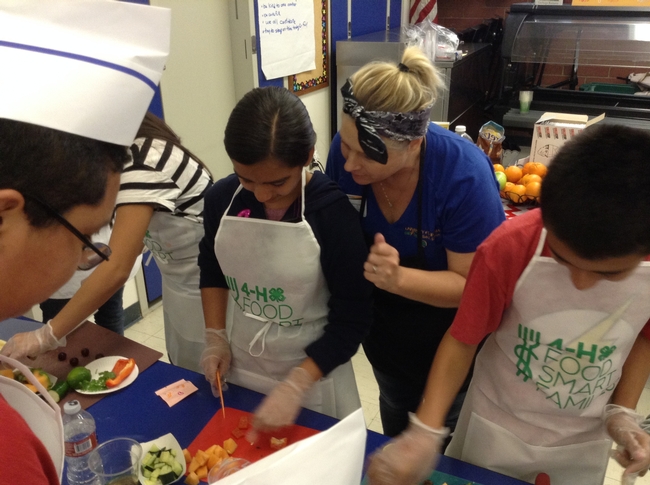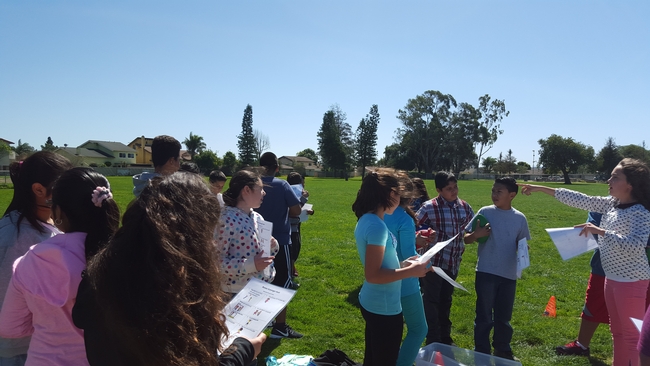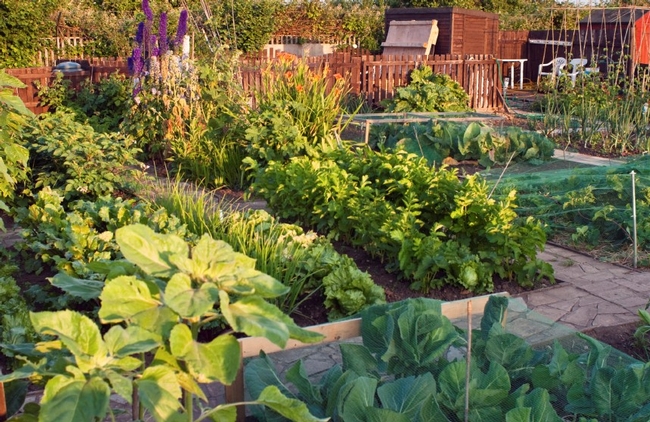Posts Tagged: ucce
Homeless people cultivate food, better health while gardening in Alameda County
Fresh fruits and vegetables are essential to a healthful diet, but it's hard to keep perishable foods on hand if one doesn't have a refrigerator or a home. To enhance the health of homeless people, the CalFresh Healthy Living, UC Cooperative Extension team in Alameda County has partnered with the South County Homeless Project to grow fresh produce for people staying at the emergency housing in Hayward.
For the past seven years, CalFresh Healthy Living, UCCE Alameda has been delivering nutrition lessons to residents of the South County Homeless Project, part of Building Opportunities for Self Sufficiency. The classes include Rethink Your Drink, Food Safety, Making Every Dollar Count, Eat Healthy Be Active Community Workshops, and Fresh from the Garden.
The South County Homeless Project facility houses 24 people for up to a year. With the help of the CalFresh Healthy Living, UC Cooperative Extension team, its existing garden was refurbished and redesigned. The large outdoor garden behind the facility offers therapeutic gardening opportunities to residents and provides food for their meals.
"I love the garden and when the cook cooks the vegetables, they taste amazing,” said one resident. “I am thankful for this garden and for having the CalFresh Healthy Living team.”
At one time, South County Homeless Project's backyard featured a flower garden. After years of neglect, weeds overtook the garden.
In 2022, CalFresh Healthy Living, UCCE Alameda proposed getting residents involved in growing food by resurrecting the garden with edible plants.
“Not only could we continue to engage residents in nutrition education classes, but we could also work together to reinvigorate their neglected garden,” said MaxFairbee, nutrition educator withCalFresh Healthy Living team,UCCE Alameda.
More than 15 varieties of herbs and vegetables planted
Residents and staff set out to replace the weedy beds with a vegetable and herb garden.
“We worked with South County staff and residents on the design, clean up, planting, harvesting and ultimately incorporating food from the garden into the kitchen for residents to enjoy the fruits of their labor,” Fairbee said.
For gardening expertise and support, Fairbee enlisted the UC Master Gardeners of Alameda County's Community Garden Team to help. While the CalFresh Healthy Living, UCCE staff continued providing nutrition classes, the UC Master Gardener volunteers trained the residents on the basics of gardening.
In April, after heavy rains, the group planted 50 seedlings, half donated by the UC Master Gardeners. They planted two varieties of lettuce,arugula, four varieties of tomatoes, zucchini, kale, onions, cucumbers, green beans, Swiss chard, kale, basil, cilantro, tarragon, thyme, parsley, rosemary, oregano and mint.
From garden to table
“In May, we harvested lettuce and in June, we harvested green beans, cucumbers, kale and onions,” Fairbee said.
The fresh vegetables and herbs were used to prepare salads, sandwiches and pasta dishes for the residents. Fairbee and the other educators have also used the fresh produce for cooking demonstrations and tastings as part of their Fresh from the Garden class.
"We have been able to use many of the veggies as sides or to go in the salad," said one of the South County Homeless Project cooks.
"One of the chefs used the zucchini in the pasta sauce, it was so good! I didn't really know you could use it that way!" said a resident.
After tasting summer squash andgazpacho made with tomatoes from the garden, a South County resident namedSelina said, "I was surprised how good the raw summer squash tasted and how the flavor was different after it was cooked. I'll definitely be adding more zucchini to my plate."
Challenges to keeping the garden going
To keep the garden healthy, they faced competition with plant-chewing snails, slugs and aphids and cats digging in the soil. Because the water source is over 200 feet from the garden, they run a long hose across the main path, along the parking lot to water the plants, then unhook the hose and stash it indoors after each use so that it won't get stolen.
Another challenge of maintaining the garden is getting enough residents and staff to volunteer to work on it.
“Although staff are supportive of the garden, none actually have time to work in the garden,” Fairbee said.
The residents harvest, wash and store the produce in the kitchen. Only four to six of the 24 residents are typically interested in working in the garden, pulling weeds and protecting the plants from pests – most are focused on getting a new job and a home. South County residents usually leave the temporary housing within a few months.
For more consistent garden maintenance, Fairbee is looking to other community groups for volunteers. He is also hoping to persuade the county government to install a water spigot close to the garden so they can install drip irrigation to water the garden.
“We'd like to work with the UC Master Food Preservers to teach residents how to preserve herbs and vegetables,” Fairbee said.
He hopes South County Homeless Project residents will continue gardening in their new homes to grow fresh vegetables so they can enjoy a more nutritious diet and better health.
Beyond the fresh food, the South County Homeless Project residents and staff enjoy the ambience of the garden.
"It's really nice to go back there and just sit, it's really peaceful," said one staff member.
A resident added, "(The garden) relaxes me from stress. I love the garden."
Organic Ag Institute begins forming knowledge network, assessing needs
Cal OAK Network to build on, grow connections between UC and organic community
After pioneering the organic movement in the 1970s, California now leads the nation in number of organic farms, total organic acreage and overall organic crop value. Attaining this status was no small feat, and largely driven by resourceful growers who developed and refined the wide range of novel organic farming practices seen in California today.
Now, with the creation of the Organic Agriculture Institute, the University of California will be able to leverage its vast capacity for research, extension and education to further improve the sustainability, resilience and profitability of organic agriculture in the state.
In its first major public initiative, the Organic Agriculture Institute – a program of UC Agriculture and Natural Resources – is conducting a statewide needs assessment for organic agriculture, as well as forming a knowledge-sharing network that connects UC experts with growers, processors, producer organizations, certifiers, crop consultants, community groups and state agencies.
“This network will be a sustainability partnership that enables learning, innovation and cooperation among organic agriculture stakeholders,” said Houston Wilson, director of the Organic Agriculture Institute, which was established in January 2020. “As facilitator of the Cal OAK Network, the Organic Ag Institute will serve as an intermediary that fosters communication among stakeholder groups, organizes discourse, forges new collaborations, and generally enhances coordination of stakeholder activities.”
By creating closer connections between the UC and the organic community, the Cal OAK Network will foster ongoing feedback cycles of knowledge and best practices, and in doing so help create the conditions and momentum to facilitate the development and adoption of organic production practices.
“The Cal OAK Network will better connect the organic community with UC technical and training resources, while at the same time providing a mechanism for that community to feed information back to the UC that helps us shape our programs at the Organic Ag Institute,” said Wilson, noting potential contributions in areas such as pest control, weed management and crop nutrition.
In the first 18 months of the Institute, Wilson has been charting the current landscape of organic agriculture in California, listening to the needs of stakeholders and working to position the Institute in a way that best uses the UC's unique research and extension capacities to support and augment existing efforts by growers and other groups.
The Institute recently received a planning grant from the National Institute of Food and Agriculture to conduct a formal needs assessment through summer 2022. In surveying growers and other stakeholders, the Institute seeks to identify their primary research and extension priorities, as well as gain a better understanding of the key people and organizations they currently rely on for information about organic production.
Through this process, a map of nodes and connections in the organic community will also take shape – and the roster of members for the Cal OAK Network will continue to grow. As Wilson points out, it is only through a diverse and robust information-sharing system that California organic agriculture will successfully adapt to challenges like climate change.
“We're trying to create a resilient infrastructure for engagement with organic stakeholders,” he said. “When we talk about sustainability in agriculture, part of that is having sustainable institutions that function well and can be flexible and dynamic as new challenges arise down the road.”
To learn more about and join the California Organic Agriculture Knowledge Network, visit organic.ucanr.edu and contact Wilson at hwilson@ucanr.edu.
Inspiring youth leaders to cultivate health
What are sixth-graders interested in these days? “Cooking!” “Growing food!” “Learning how to be healthier.” “Exercising.” “Meeting new friends!” These enthusiastic answers came from sixth-grade student leaders in Santa Maria, Calif., when asked by educators from the UC Cooperative Extension Youth, Families and Communities program in San Luis Obispo and Santa Barbara counties.
Through an integrated youth-focused healthy living project, called Food Smart Families, funded by National 4-H, the UC ANR 4-H Youth Development Program, and the UC CalFresh Nutrition Education program, 32 fourth- through sixth-grade student leaders were brought together from three schools in Santa Maria, Calif., for a full-day educational retreat that focused on engaging youth to explore their healthy lifestyle interests and see themselves as leaders.
Throughout the day, student leaders experienced physical activity games, learned cooking skills, participated in garden-based learning, and developed their presentation skills. They focused on skill development, as well as transference so that the student leaders could take these activities into their own schools to encourage and teach their peers. For example, the fun physical activity breaks that were incorporated throughout the day modeled games where no one is “out” or excluded, while moving enough to get heart rates up.
After the retreat, the student leaders brought these activities to their own schools, leading their peers in the games during lunch and recess breaks. During the retreat, the student leaders also got to practice knife safety skills while chopping produce to prepare their own veggie pita pockets and fruit salads. With these skills, the student leaders offered food demonstrations and nutrition lessons to their peers during the following weeks.
In the garden, student leaders learned the basics of growing food and how to lead a garden lesson. Students discussed garden tools and how to use them safely, then planted their own seeds to take home. The garden session ended with a gleaning of the school citrus orchard where students laughed and enjoyed the fresh air and fresh fruits growing around them. In their own school gardens, the student leaders have offered lessons and tastings to their peers.
The retreat culminated with youth presentations. The student leaders worked in teams with students from different schools to generate ideas and artwork for the Student Nutrition Advisory Council (SNAC) logo and t-shirt design. They presented their concepts to the larger group, practicing their presentation skills. The student leaders voted on the designs and a winner was selected to be featured on a t-shirt for SNAC leaders at each of the three schools. The students leaders proudly wear their shirts as they lead healthy living education, advocacy and engagement activities.
By the end of the retreat, the student leaders were excited to take the information and skills back to their schools and start leading. Students shared their plans to help other students be more active during recess, be healthy, and help other kids be healthier too.
“This was the best day I have ever had,” said one of the students.
Since the retreat, the student-led initiatives have been numerous and continually evolving. The sixth-graders have encouraged and trained younger students to become their successors as they move onto junior high. Several students co-authored and starred in a video production called “Get to Know Your Salad Bar.” With educator encouragement, the student leaders developed a script to motivate their peers to try out the salad bar by mixing fruit into their salad to make it sweet or putting lettuce and tomato on your hamburger to make it juicy and crunchy. Beyond leading in their own schools, the student leaders have been working to help their entire community. Many of the student leaders helped organize and conduct game-style nutrition activities at a local food pantry distribution to teach families about shopping for healthy foods on a limited budget. Other student leaders provided education and training to students at neighboring schools, encouraging them to become leaders as well.
Through the efforts of the Food Smart Families program, the Youth, Families, & Communities program in San Luis Obispo & Santa Barbara counties merged the strengths of the UC CalFresh Nutrition Education program and the UC ANR 4-H Youth Development program to provide new opportunities and experiences for students in this community. With interested and caring adults, these student leaders learned to share their passions for cooking, gardening, and healthy lifestyle with their peers at school and others in their community. The rewards for the school, community and adult allies continue to expand as these inspired student leaders, with strong mentorship and support, take on some of the biggest challenges facing our society and world.
Three winter activities for a bountiful summer harvest
Shorter days and colder weather means most people aren't thinking about spending large amounts of time in their garden. However, February is the perfect month to plant cool season leafy vegetables or root plants, like cabbage, beets and carrots. These nutrient-rich plants are packed with healthy antioxidants and vitamins and make the perfect addition to a hot bowl of soup. If you aren't game to play outdoors, cold winter months are a great time to stay inside and start planning for summer garden fruit and vegetable bounties.
If you're like most people you're probably already dreaming about summer fruits and vegetables, like tomatoes, sweet corn, blackberries and chard. Follow these three simple tips and you'll be rewarded come summertime with enough homegrown fare to fill your fridge and preserve to carry you through the year.
Step one: plan
Instead of dreaming about a summer harvest, start planning now! Don't get caught up in the seductive call of seed packets or the dreaded 'transplant trap.' This happens when you head to your local nursery without a plan for your garden and leave with 20 plants you've never heard of before.
With California in an official drought, consider planting varieties that require less water. Some great examples of drought-tolerant plants include herbs (rosemary, sage and thyme), asparagus, eggplant, melons, squash and goji berries. Think about Mediterranean flavors, many of these varieties require less water and do well in California's hot, dry climate.
Think outside the box – it doesn't have to be just about fruits and vegetables. What does your family love to eat? Do they love spaghetti? Consider focusing on a good crop of tomatoes, peppers, onions and oregano. You can harvest enough to preserve homemade marinara for the remainder of the year. Add some jalapenos to this garden mix and you have all of the ingredients for delicious salsa, another favorite that is easily preserved.
Step two: prioritize
The size of your garden will depend on available space. When planning a smaller garden, typically 10 by 10 feet or less - prioritize with fruits and vegetables that your family will eat AND that have high or continuous yields. The goal is to produce the largest quantity possible with your available resources (space, water). Great options include tomatoes, bush beans, summer squash, chard and cucumbers. In a small space, avoid crops that monopolize precious garden space like potatoes, watermelon, cabbage and artichoke. Rather, consider purchasing these tasty delights from a local farmers market.
Expand your garden's reach by incorporating edibles into your landscaping or containers. Edible landscaping is the use of food plants as design features in a landscape. Edible plants can be used both for aesthetic value as well as consumption. Blueberries, raspberries and strawberries can be expensive to buy at the supermarket, but are easy to grow at home. Visit The California Garden web for information on garden planning and individual plant spacing requirements.
Step three: prepare
Attend a UC Master Food Preserver class and learn how to manage your fruits and vegetables once they arrive from your garden and move into your kitchen. The UC Master Food Preserver (MFP) Program is a public service community outreach program focused on providing up-to-date information on food safety and preservation. Monthly classes are available, and most are free or low-cost to the public.
Preservation techniques include:
- Freezing (berries, onions, broccoli, rhubarb)
- Drying (fresh herbs, kale, root crops, peas)
- Canning (tomatoes, green beans, corn, strawberries)
Master Food Preservers have delicious recipes for salsa, corn relish, pickles, jams, jellies and much more! Winter months are the perfect time to start calendaring Master Food Preserver classes, collecting recipes and cataloging ideas for preserving your summer bounty. Find preserving research, resources or find a local UCCE Master Food Preserver class near you at on the UC Food Safety website.
With the proper planning, prioritizing, and preparation the activity level in your kitchen will be as hot as or even hotter than the temperature outside come summer harvest!
Are you interested in becoming a certified UC Master Gardener or UC Master Food Preserver? Visit our website to learn more!


